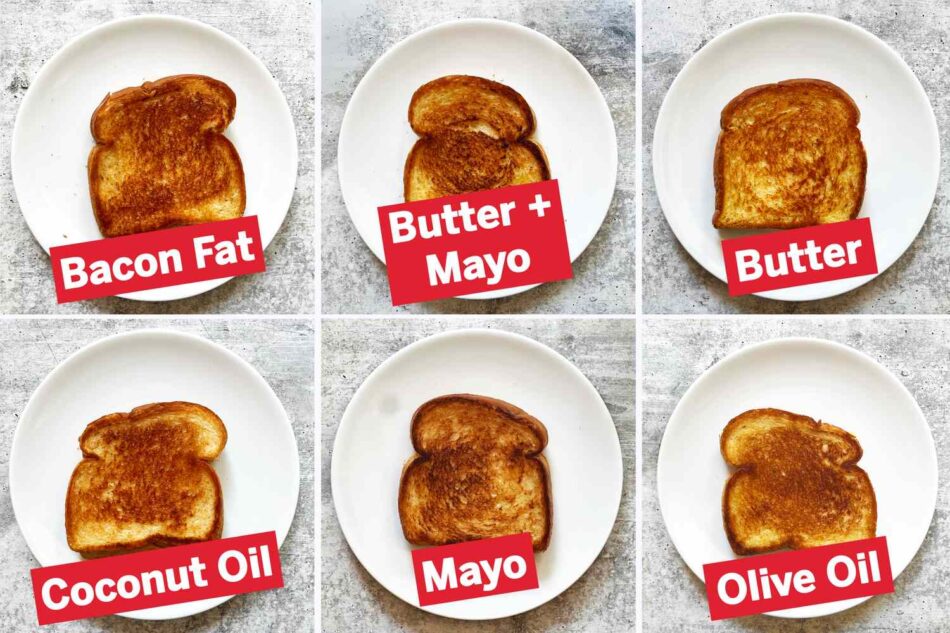- For superior flavor and a superbly crispy texture, butter your bread using a high-quality brand like Kerrygold.
- Coconut oil was a surprise hit, yielding the crispiest crust and a mild flavor that allowed the cheese to shine.
- The most important factor for a crisp exterior and gooey cheese is not the cooking fat, but patience: Cook over medium-low heat for about four minutes on each side.
One of the first things most folks learn to cook for themselves is a grilled cheese sandwich. It’s a quick, comforting standby that enhances a bowl of tomato soup, makes a fantastic accompaniment to chili, and serves as a hearty snack any time of day or night. But we’ve all been let down before by subpar grilled cheese, one rendered inferior by the ingredients and/or technique. How can you ensure a great grilled cheese every time?
There are lots of methods people tout for making “the best” grilled cheese, most of which rely on what you choose to coat your bread with. That’s what we decided to test here. The bread and cheese remained constant, but the choice of schmear, I learned, can make or break your sandwich. It can complement the other flavors, clash with them, or even overpower them.
Read on for the not-so-secret key to an irresistible grilled cheese — plus a surprising method that yielded drag-your-knife-over-the-surface crispiness.
A word about my method
As mentioned above, the bread and cheese remained constant among all tests. I used presliced white sandwich bread and American cheese for the most classic iteration of the sandwich.
To cook each sandwich, I used a 10-inch cast-iron skillet heated over medium-low. I used the same stove eye and skillet (wiping it clean between tests) for all of the tests. I cooked each sandwich for about 4 minutes per side, until it seemed properly browned.
I spread 1 1/2 teaspoons of each schmear onto each bread slice. This was enough to coat and lubricate without sogging out the bread. I also used one slice of American cheese per sandwich to better taste the bread and schmear.
Mayonnaise
Food & Wine / Ann Taylor Pittman
Cook time: 8 minutes
Total time: about 9 minutes
Rating: 4/10
Method: For this test, I used my favorite store-bought mayo (Duke’s) and spread 1 1/2 teaspoons over each bread slice. This is a technique you’ve no doubt seen people tout before. They say that coating the bread with mayo gives you a higher smoke point and less chance of burning, that it creates the Maillard reaction for more savory notes, and that it yields a superior crust.
Results: First off, let me explain that I like mayonnaise. I slather Duke’s on my BLTs, and it has become my condiment of choice for all my homemade burgers. But I beg to differ with those who claim it’s the best bread coating for grilled cheese. As we have noted before, mayo gives the grilled cheese a slightly greasy texture. It’s crispy, yes, but no crispier than most of the other methods. As for the higher smoke point, that’s not an issue when you cook your grilled cheese low and slow over medium-low heat.
With mayo, my sandwich actually got darker around the edges than with some of the other methods. But my biggest objection was the flavor. When that warm mayo is on the exterior of the sandwich and hits your palate first, you’re met with a sort of artificial, chemical-like oil flavor that’s at odds with the creamy cheese.
Pros: It’s very easy to spread on the bread.
Cons: The flavor is overpowering and not complementary to the cheese. It also results in a slightly greasy exterior.
Olive oil
Food & Wine / Ann Taylor Pittman
Cook time: 8 minutes
Total time: about 9 minutes
Rating: 7/10
Method: Here, I chose a medium-fruity extra-virgin olive oil — not the fruitiest, most peppery finishing oil but something less pungent. I brushed 1 1/2 teaspoons of it onto each bread slice before cooking the sandwich.
Results: The sandwich got very crispy, with a shattering, audible crunch. Even with a less pungent oil, though, the flavor was overpowering once warmed. The fruity, peppery quality felt at odds with the mild, creamy cheese.
Pros: The sandwich ends up with a super-crispy texture, and the oil is low in saturated fat.
Cons: The oil’s inherently strong flavor is incompatible with the cheese.
Mayonnaise/butter combo
Food & Wine / Ann Taylor Pittman
Cook time: 8 minutes
Total time: about 13 minutes
Rating: 7/10
Method: For this test, I went with my favorite salted butter, Kerrygold. I softened 2 teaspoons of it first, cutting the butter into small pieces so that it softened in a flash. I spread a teaspoon of the butter over each bread slice and then spread a thin slick of mayo over that.
Results: The sandwich cooked up crisp, and the flavor here was better than with the mayo-only grilled cheese, with some of the creamy richness of the butter coming through. But there was still an oiliness to the sandwich and a strong mayo-oil flavor that I found off-putting.
Pros: You get some nice rich notes from the butter, and the sandwich gets crisp.
Cons: That mayo flavor, though…it has a chemical aftertaste, and is still slightly greasy.
Bacon grease
Food & Wine / Ann Taylor Pittman
Cook time: 8 minutes
Total time: about 9 minutes (if you have bacon grease on hand)
Rating: 8.5/10
Method: As a true Southerner, I always have bacon grease on hand, with a special container I keep in the fridge. Even though it’s solid when cold, you don’t need to soften it to room temperature. Cold bacon grease is very spreadable, with a pudding-like consistency. As with all the other methods, I used 1 1/2 teaspoons for each slice of bread.
Results: My collected bacon grease came from all kinds of recipe development projects, so its smokiness level was mid-range (it wasn’t like using super-powerful Benton’s bacon grease). The grilled cheese cooked with bacon fat had a fantastically savory, smoky, porky flavor and a good crust. I thought it was delicious, but admittedly it stole the show a bit from the cheese.
Pros: Bacon grease adds loads of savory depth and rich, meaty notes.
Cons: If you don’t have bacon grease on hand, you’ll have to cook some bacon first. And of course, if you’re vegetarian, this isn’t the method for you.
Coconut oil
Food & Wine / Ann Taylor Pittman
Cook time: 8 minutes
Total time: about 9 minutes
Rating: 9/10
Method: For this test, I used the coconut oil I keep on hand for cooking. It’s organic, refined coconut oil in a jar that’s solid at room temperature. (Refined oil has a more neutral flavor than unrefined.) It’s solid in the jar, but a quick stir with a knife loosened it enough to make it easy to spread onto the bread.
Results: I was shocked at how much I liked the grilled cheese made this way. It had a gorgeous golden crust and was extremely and audibly crispy. And the oil’s flavor was neutral, so it didn’t detract from the cheese at all.
Pros: This sandwich developed the crispiest crust of all the methods I tried.
Cons: The oil didn’t detract from the flavor of the sandwich, but it also didn’t contribute any flavor of its own.
Butter
Food & Wine / Ann Taylor Pittman
Cook time: 8 minutes
Total time: about 20 minutes
Rating: 10/10
Method: To test the butter method, I first needed to soften some butter to spread onto the bread. (I don’t like melting the butter in the pan because it never coats the bread evenly that way.) Since I was using 1 1/2 teaspoons of schmear for each slice of bread in all my tests, I cut off a 1-tablespoon pat and then cut that into 2 thinner slices so they’d soften quickly. I used my favorite salted butter, Kerrygold, and it was soft enough to spread after about 10 minutes.
Results: We’ve said it before, and I’ll reiterate it here: You simply cannot beat the flavor of butter. As the sandwich cooked, the butter crisped the bread and grew nuttier as it browned. Butter’s notorious lower smoke point and tendency to burn are negated when you cook your grilled cheese properly over medium-low heat. Here, my sandwich was fantastically crisp, beautifully golden, and developed that nutty-toasty browned butter flavor that makes for an iconic grilled cheese — the kind of sandwich you dream about and crave.
Pros: Flavor, flavor, flavor! You get the sweet cream richness of salted butter and toasty-toffee notes in every bite. The crust is beautifully crispy as well.
Cons: You have to wait a few minutes for the butter to soften enough to spread onto the bread.
Final takeaways
Turns out, the grilled cheese method you probably grew up with is the best. Good ol’ butter provides outstanding nutty, rich flavor and, when cooked over medium-low heat, yields a crispy texture that’s just as good as any other method tested here.
If you want a bigger flavor punch, try the bacon fat method, which delivers porcine richness to enhance your grilled cheese experience. If crunch is your main goal, try the coconut oil method — it just might surprise you.









